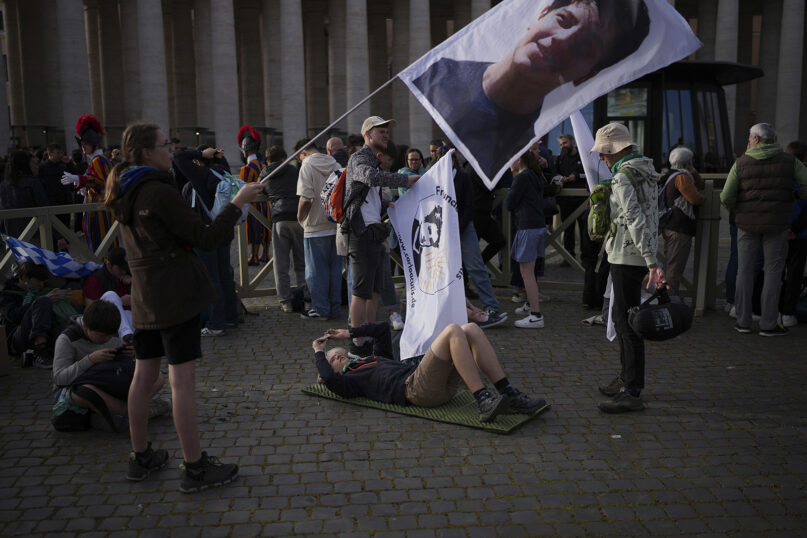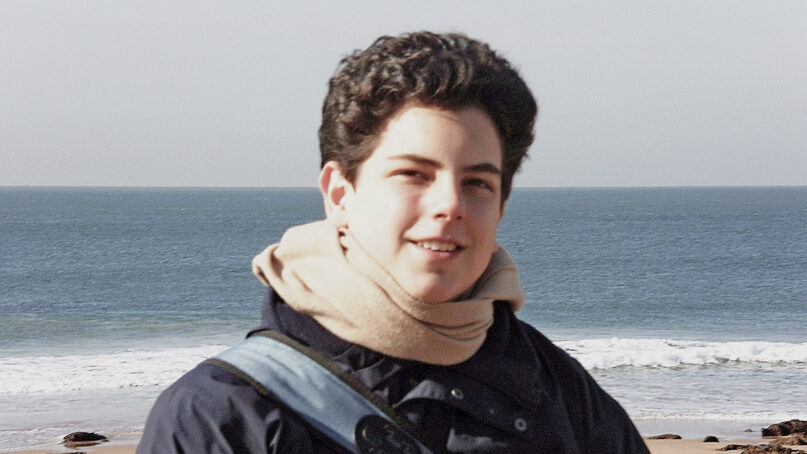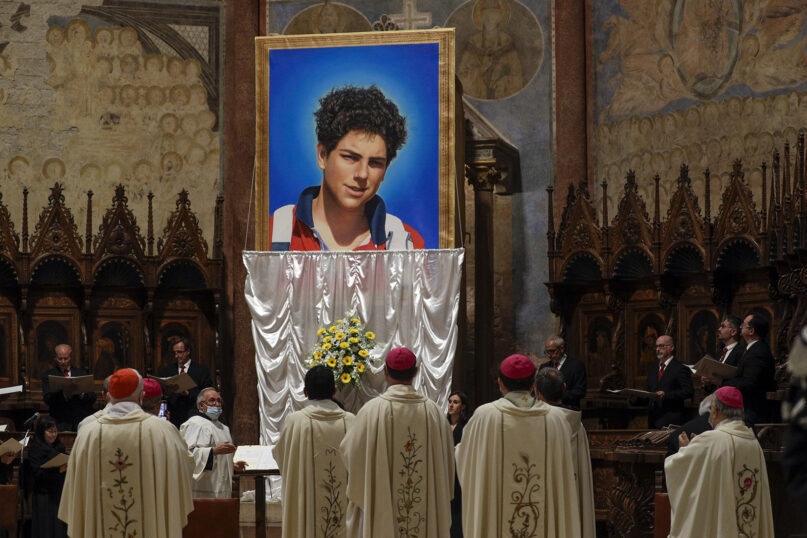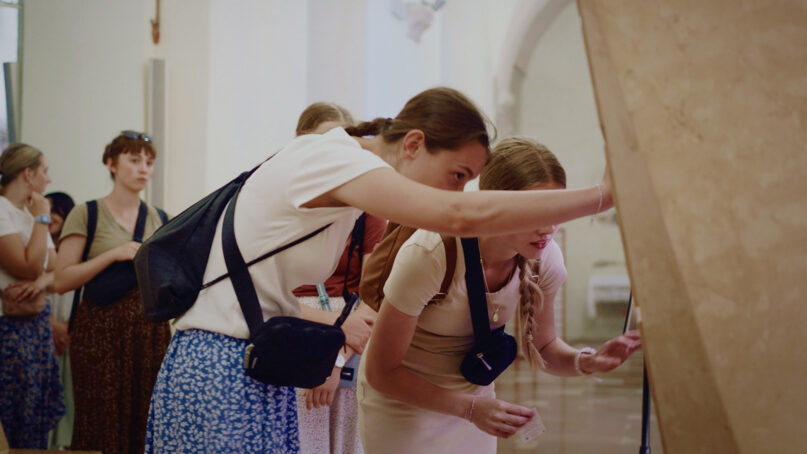VATICAN CITY (RNS) — In a low-definition video, sitting behind a desk in front of a blue, plain backdrop, the 15-year-old Carlo Acutis looks straight into the camera: “I am destined to die,” he says, followed by a smile, an enigmatic roll of his shoulders, and a clap. Two months later, on Oct. 12, 2006, he died of acute myeloid leukemia.
The curly haired Italian kid could not have known at the time that he would become the first millennial saint who would inspire thousands of believers of all ages to venerate “God’s influencer.”
Initially scheduled for April 27, Acutis’ canonization at the Vatican was postponed when Pope Francis died on April 21. Pope Leo XIV announced Friday (June 13) that Acutis will be sainted Sept. 7, along with another young person, Blessed Pier Giorgio Frassati.
Acutis’ “reputation of holiness,” part of any saint’s cause, has taken the church by storm. He is referred to by many names: the saint in sneakers, the patron of the Internet, God’s jester or — as Pope Francis described him — the saint next door.
But what’s so special about Acutis? How was this seemingly ordinary teenager able to inspire so many people? The unique aspect of the first millennial saint is that his life is not buried in history books or hidden in dusty archives; people can grasp who he was by talking to those who knew him, watching pictures and videos of him and even tracing the few footprints he left on the Internet.
His family, friends and teachers describe him as a kid like many others, someone who was always up for a laugh, failing at math but sought after by girls and keen on video games and movies. They describe him as a good person who helped those in need and went out of his way to be kind. Some also describe his devotion to the Eucharist, his daily visits to church and his timid yet resolute defense of his Catholic faith.

A faithful waves a flag with Carlo Acutis at the funeral of Pope Francis in St. Peter’s Square at the Vatican, Saturday, April 26, 2025. (AP Photo/Emilio Morenatti)
Acutis is proof that anyone can become a saint in the Catholic Church, an aspiration that any believer is encouraged to achieve. But the church’s process of canonization, with its many steps and investigations, rules and rituals, pilgrims and relics, exists in a separate reality that few fully grasp. The machine of Acutis’ sainthood process, spread in every continent and across all media, has overshadowed the reality of Carlo’s life.
In some respects, Acutis was not your average 15-year-old boy. Born in London on May 3, 1991, into a very wealthy family, he enjoyed a life of privilege. His father, Andrea Acutis, runs a prominent Italian insurance company, Vittoria Assicurazioni, and his mother, Antonia Salzano, came from a near-aristocratic family with ties to the publishing industry.
Acutis spent his short, sheltered life in Milan, carefully attended to by babysitters and attending private Catholic schools in the Italian financial capital. Miraculously enough, Acutis’ friends say that he was down to earth and empathetic.
“Carlo lived his privilege in a very normal way. One felt at home in his house. He was a boy who didn’t put up walls — some people we knew had a much more snobbish attitude, but he was able to befriend anyone,” said his best friend from middle school, Federico Oldani. “But he also saw wealth as a responsibility, a means to help others.”
Oldani said he knew about Acutis’ religious beliefs but that it wasn’t something he openly shared. “His faith was very discrete, intimate,” he said. “I think he reserved his religious side for private moments or the parish, where it was appropriate.”

Carlo Acutis. (Courtesy photo)
Some who knew him said they weren’t struck by Acutis’ faith — in fact many didn’t even know he was Catholic. “He was a very reserved person, very curious, always asking questions, but at the same time very private … meaning that I only learned certain things about him later,” said Fabrizio Zappa, who taught Acutis religion at Milan’s Leo XIII Institute, a Catholic high school, from 2005 until Acutis’ death.
Zappa described Acutis as “always smiling” and willing to help others but had only a few hints of his spirituality: Acutis was the only one in his class to voice an interest in spiritual discussion groups and defended Catholic teaching on abortion during a classroom debate. “I feared he was being the teacher’s pet,” Zappa said.
Acutis made a video for Zappa’s class on the importance of volunteer work. His black-and-white footage shows his classmates walking like ghosts, each concerned with their own problems, ignoring a man in a wheelchair they pass. One of the classmates stops and looks at the man, filling the screen with colors. Acutis was reportedly known to say, “We are all born originals, but many of us die as photocopies.”
But Zappa said he was surprised when he heard that his former student would become a saint. “I didn’t want to believe it initially, in the sense that there could have been so many others just like him, the saints next door,” he said.
Others had the chance to see Acutis’ charity and faith up close. His parents, who described themselves as only culturally Catholic, claim that they were converted by their son’s zeal and love for Christ. His guardian and housekeeper, Rajesh Mohur, a Hindu Brahmin from Mauritius, claims he was converted by Acutis, whom he referred to as his “little catechist.”
According to reports from those who knew him, Acutis volunteered to help the poor and marginalized, and he worked as a catechist in his parish. Perhaps one of the most extraordinary examples of Acutis’ attention toward others is shown by his continued outreach to a young classmate, Andrea Pobbiati, who was a bit of an outcast at school and struggling at home. Pobbiati was stabbed to death in his trailer at 22 in 2014.

An image of 15-year-old Carlo Acutis is unveiled during his beatification ceremony, celebrated by Cardinal Agostino Vallini in the St. Francis Basilica, in Assisi, Italy, on Oct. 10, 2020. (AP Photo/Gregorio Borgia)
Acutis is best known for his devotion to the Eucharist. Mons. Gianfranco Poma, the parish priest of his church, Santa Maria Segreta in Milan, wrote in an article on the diocesan paper about the “honest and smiling” teenager who would come almost every day to pray and adore the Eucharist.
Oldani, who today is an aerospace engineer, said Acutis taught himself how to code and used his knowledge to create a website detailing Eucharistic miracles, saying often, “The Eucharist is the highway to heaven.”
Some who knew him found the idea of Acutis’ sainthood confusing. “His classmates, I must be honest, haven’t fully processed this thing,” said Zappa, adding that some viewed the canonization of Acutis as “a kidnapping.”
“Their way of reacting is by saying no, Carlo was one of us and we want to remember him like one of us, not like some saint to be honored at the altar,” Zappa said. Many of Acutis’ classmates have asked that their contact information not be disclosed to journalists.
Oldani and some other friends were surprised when people flocked to Acutis’ funeral Mass, recounting stories of his holiness, and even more surprised when a growing number of followers began posting religious content on the Facebook group his friends had created after his death.
“I quickly realized that he would become a saint,” Oldani said, “because I immediately realized that there was an immediate interest and attention to him.” But his friend said he was surprised by how quickly Acutis’ sainthood process went. “In my mind, I thought it would happen when I was 80 years old and an old man,” he said.
Centuries ago, it was not uncommon for saints to be proclaimed by popular acclamation, until, in the 1600s, the Vatican ruled that at least 50 years had to pass before a person could be proclaimed a saint, according to Kenneth L. Woodward, author of “Making Saints: How the Catholic Church Determines Who Becomes a Saint, Who Doesn’t, and Why.”
Under Popes Paul VI and John Paul II, the canonization process was sped up to avoid losing precious information about the candidate to time, Woodward explained, but what matters most “is creating a story to be told” — a model for faithful to aspire to.
Two miracles have been attributed to Acutis: the miraculous healing of a Brazilian child suffering from a pancreatic disease in 2013 and the sudden recovery of a Costa Rican woman suffering a head injury in 2022. “You can study a person’s life, but that is a human endeavor,” Woodward said. “You need a sign confirming that the person is actually a saint.”
But canonization remains “a very human process,” Woodward added. There is a considerable sum of money involved, as much as 1 million euros to pay for lawyers, postulators, researchers and paperwork. As a result, criticism has been weighed against the Vatican’s increased saint-making zeal, which earned the department the title of “the workshop of saints.”

Young pilgrims view the body of Carlo Acutis at the Santa Maria Maggiore Church in Assisi, Italy, in a still from “Carlo Acutis: Roadmap to Reality.” (Photo courtesy Carlo Acutis: Roadmap to Reality)
Francis reformed the Vatican department charged with dispensing halos in 2022, simplifying procedures and imposing rigid controls on the management of funds.
Woodward believes that it’s unlikely for people to be able to influence canonization causes today, but he did admit that the creation of the “reputation for holiness,” through books, media and movies leaves ample space for well-connected and wealthy Catholics to further the sainthood of their preferred candidate.
Acutis’ fame quickly grew far beyond the confines of the small neighborhood in Milan where he lived and studied. Official reports stated that hundreds of thousands come to see his resting place in the town of Assisi in central Italy, where they can see him wearing a sweatshirt and sneakers, with an uncannily realistic wax mask that resembles his face while sleeping.
The disarming simplicity of Acutis’ holiness has drawn young people to the Catholic Church, which has long struggled to connect with new generations. A new documentary, “Carlo Acutis: Roadmap to Reality,” captures the profound impact the young future saint had on a group of high school students from North Dakota.
His life has been explored in dozens of books, podcasts, articles and films, many created with younger audiences in mind. In this, Acutis shares something with the medieval St. Francis of Assisi, whose first biography was written soon after his death in 1226 by a close companion, Thomas of Celano. That biography was only the beginning. “The Little Flowers of St. Francis,” a later collection of legends and stories, became one of the most beloved books of the Middle Ages and helped spread Francis’ fame across Europe. He was canonized just two years after his death.
Acutis’ body was moved to the Sanctuary of the Renunciation in 2017, the location where St. Francis renounced all his worldly possessions. Acutis had a deep connection to the city, according to the Archbishop Domenico Sorrentino, in his book, “Carlo Acutis in the footsteps of Francis and Chiara of Assisi — Originals not photocopies.”
“Francis had a very special holiness, a charismatic holiness, a prophetic holiness that also relied on doing things that are very difficult to do,” Sorrentino told Religion News Service, referring to the medieval saint’s embrace of poverty and his attempt to broker a peace between the pope and the Muslim world.
“Carlo is a translation of sainthood in modern and contemporary terms,” he said. “Carlo puts us with our backs against the wall in our call to holiness and says: ‘listen, if you can’t do what Francis does, at least do what I do.’”
Today, Sorrentino said, more pilgrims come to Assisi to visit Acutis’ tomb than St. Francis’.
Many of Francis’ earliest followers were his wealthy friends, and after his death, thousands of young men joined the Franciscan order he founded. His emphasis on preaching and public conversion played a key role in this growth. Acutis’ influence, however, stems not from preaching but from a quietly radiant, personal faith.
In a society overflowing with noise and competing voices — especially for the attention of the young — the “Roadmap to Reality” film suggests Acutis offers something different: a faith that shines inward, inviting believers to look within.



